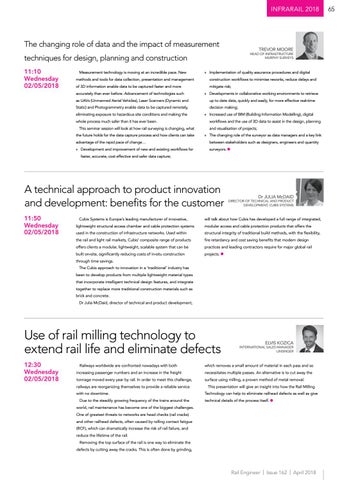INFRARAIL 2018
The changing role of data and the impact of measurement
TREVOR MOORE
HEAD OF INFRASTRUCTURE MURPHY SURVEYS
techniques for design, planning and construction 11:10 Wednesday 02/05/2018
Measurement technology is moving at an incredible pace. New methods and tools for data collection, presentation and management of 3D information enable data to be captured faster and more accurately than ever before. Advancement of technologies such as UAVs (Unmanned Aerial Vehicles), Laser Scanners (Dynamic and Static) and Photogrammetry enable data to be captured remotely, eliminating exposure to hazardous site conditions and making the whole process much safer than it has ever been. This seminar session will look at how rail surveying is changing, what the future holds for the data capture process and how clients can take
»» Implementation of quality assurance procedures and digital construction workflows to minimise reworks, reduce delays and mitigate risk; »» Developments in collaborative working environments to retrieve up to date data, quickly and easily, for more effective real-time decision making; »» Increased use of BIM (Building Information Modelling), digital workflows and the use of 3D data to assist in the design, planning and visualisation of projects; »» The changing role of the surveyor as data managers and a key link
advantage of the rapid pace of change…
between stakeholders such as designers, engineers and quantity
»» Development and improvement of new and existing workflows for
surveyors.
faster, accurate, cost effective and safer data capture;
A technical approach to product innovation and development: benefits for the customer 11:50 Wednesday 02/05/2018
Cubis Systems is Europe’s leading manufacturer of innovative,
Dr JULIA McDAID
DIRECTOR OF TECHNICAL AND PRODUCT DEVELOPMENT, CUBIS SYSTEMS
will talk about how Cubis has developed a full range of integrated,
lightweight structural access chamber and cable protection systems
modular access and cable protection products that offers the
used in the construction of infrastructure networks. Used within
structural integrity of traditional build methods, with the flexibility,
the rail and light rail markets, Cubis’ composite range of products
fire retardancy and cost saving benefits that modern design
offers clients a modular, lightweight, scalable system that can be
practices and leading contractors require for major global rail
built on-site, significantly reducing costs of in-situ construction
projects.
through time savings. The Cubis approach to innovation in a ‘traditional’ industry has been to develop products from multiple lightweight material types that incorporate intelligent technical design features, and integrate together to replace more traditional construction materials such as brick and concrete. Dr Julia McDaid, director of technical and product development,
Use of rail milling technology to extend rail life and eliminate defects 12:30 Wednesday 02/05/2018
ELVIS KOZICA
INTERNATIONAL SALES MANAGER LINSINGER
Railways worldwide are confronted nowadays with both
which removes a small amount of material in each pass and so
increasing passenger numbers and an increase in the freight
necessitates multiple passes. An alternative is to cut away the
tonnage moved every year by rail. In order to meet this challenge,
surface using milling, a proven method of metal removal.
railways are reorganizing themselves to provide a reliable service with no downtime. Due to the steadily growing frequency of the trains around the
This presentation will give an insight into how the Rail Milling Technology can help to eliminate railhead defects as well as give technical details of the process itself.
world, rail maintenance has become one of the biggest challenges. One of greatest threats to networks are head checks (rail cracks) and other railhead defects, often caused by rolling contact fatigue (RCF), which can dramatically increase the risk of rail failure, and reduce the lifetime of the rail. Removing the top surface of the rail is one way to eliminate the defects by cutting away the cracks. This is often done by grinding,
Rail Engineer | Issue 162 | April 2018
65
